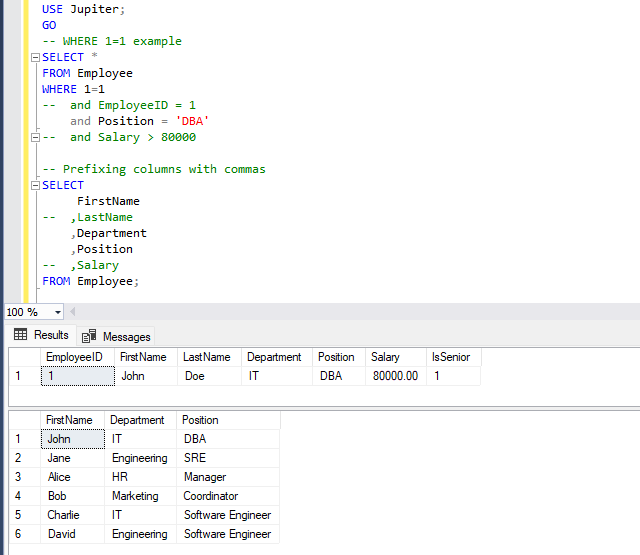When delving into SQL queries, you may come across the puzzling WHERE clause condition: WHERE 1=1. This leaves many wondering, why use it, and what purpose does it serve?
Understanding WHERE 1=1
The condition WHERE 1=1 essentially translates to WHERE TRUE. Surprisingly, its inclusion in a query doesn’t alter the result set; it returns the same outcome as the query without the WHERE clause. Moreover, it has no impact on the query’s execution time.
Practical Application:
The WHERE 1=1 condition is a convenient tool for constructing and modifying SQL queries. Here’s how it works:
-- WHERE 1=1 example
SELECT *
FROM Employee
WHERE 1=1
-- and EmployeeID = 1
and Position = 'DBA'
-- and Salary > 80000
By using WHERE 1=1, subsequent conditions can consistently employ the AND operator. This proves handy for commenting out conditions during exploratory SQL queries, providing a seamless way to toggle criteria on and off.
Additional Technique: Commenting Columns
Similar to the WHERE 1=1 technique, another approach involves placing commas before column names rather than after. This can be beneficial when commenting out columns in a work-in-progress SQL query.
-- Prefixing columns with commas
SELECT
FirstName
-- ,LastName
,Department
,Position
-- ,Salary
FROM Employee;

Embracing Convenience in SQL Querying
Efficiency is key in the realm of SQL, and adopting convenient practices enhances productivity. Personal preferences vary, and what might work for one might not for another. Experimenting with different techniques, shortcuts, and interfaces helps discover optimal workflows tailored to individual preferences.
Conclusion
The WHERE 1=1 SQL trick, though seemingly cryptic, unfolds as a practical aid for SQL developers. It offers a simple way to manage conditions and streamline the query-writing process. As with any tool, its usefulness may vary, but having it in your SQL toolkit provides flexibility for different querying scenarios.
Note: If you’re curious about the impact of changing WHERE 1=1 to WHERE 1=2, check out my other blog post – Why Use WHERE 1=2 in SQL.

One thought on “WHERE 1=1 in SQL Queries”